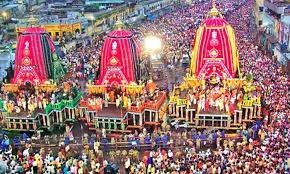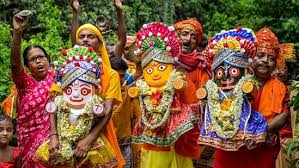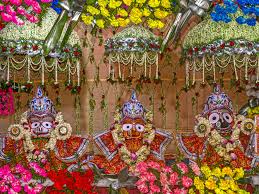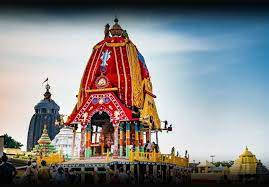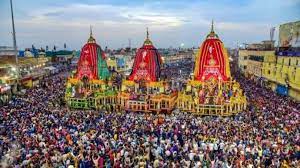
The three chariots of Jagannath, Balabhadra and Subhadra are newly constructed every year with wood of specified trees like phassi, dhausa, etc. They are customarily brought from the ex-princely state of Dasapalla by a specialist team of carpenters who have hereditary rights and privileges for the same. The logs are traditionally set afloat as rafts in the river Mahanadi. These are collected near Puri and then transported by road.[6] The three chariots are decorated as per the unique scheme prescribed and followed for centuries stand on the Bada Danda, the Grand Avenue. The chariots are lined across the wide avenue in front of the temple close to its eastern entrance, which is also known as the Sinhadwara or the Lion's Gate. Around each of the chariots are nine Parsva devatas, painted wooden images representing different deities on the chariots' sides. Each chariot has a charioteer (Sarathi) and four horses. Hera Panchami is a ritual observed during the period of Rath Yatra in the Grand Jagannath Temple of Puri. It is known as a ritual of Goddess Lakshmi. The fifth day from Rath Yatra, i.e., the fifth day in bright fortnight of Ashadha is known as the Hera Panchami.[16][17] During Ratha Yatra, lord Jagannath comes out on a divine outing with his brother Sri Balabhadra and sister Maa Subhadra along with his divine weapon Sri Sudarshana, leaving behind His wife Mahalaxmi. The Goddess expresses her anger for the deity. She proceeds to the Gundicha Temple, the Adapa Mandapa in a palanquin in the form of a Subarna Mahalaxmi and threatens Him to come back to the temple at the earliest. To make Her pleased, the deity concedes to Her by offering her agyan mala (a garland of consent). Seeing the Goddess furious, the sevakas close the main door of the Gundicha. Mahalaxmi returns to the main temple through the Nakachana gate. In a unique ritual, the Goddess orders one of her attendants to damage a part of the Nandighosa chariot. This is followed by her hiding behind a tamarind tree outside the Gundicha Temple. After some time, she escapes to her home temple in secrecy, through a separate path way known as Hera Gohri Lane[18] The unique ritual is enjoyed by lakhs of devotees of Jagannath. The rituals of Hera Panchami as an important function of Srimandira finds mention in Skanda Purana. According to the history of the Temple, this "utsav" started during the time of Maharaja Kapilendra Deb. Before his reign, the Hera Panchami function was being observed in a symbolic way with recitation of Mantras.As stated in Madala Panji, Raja Kapilendra Deb substituted this practice with the introduction of an idol of Mahalaxmi made of gold and making the celebration more realistic.[19]
